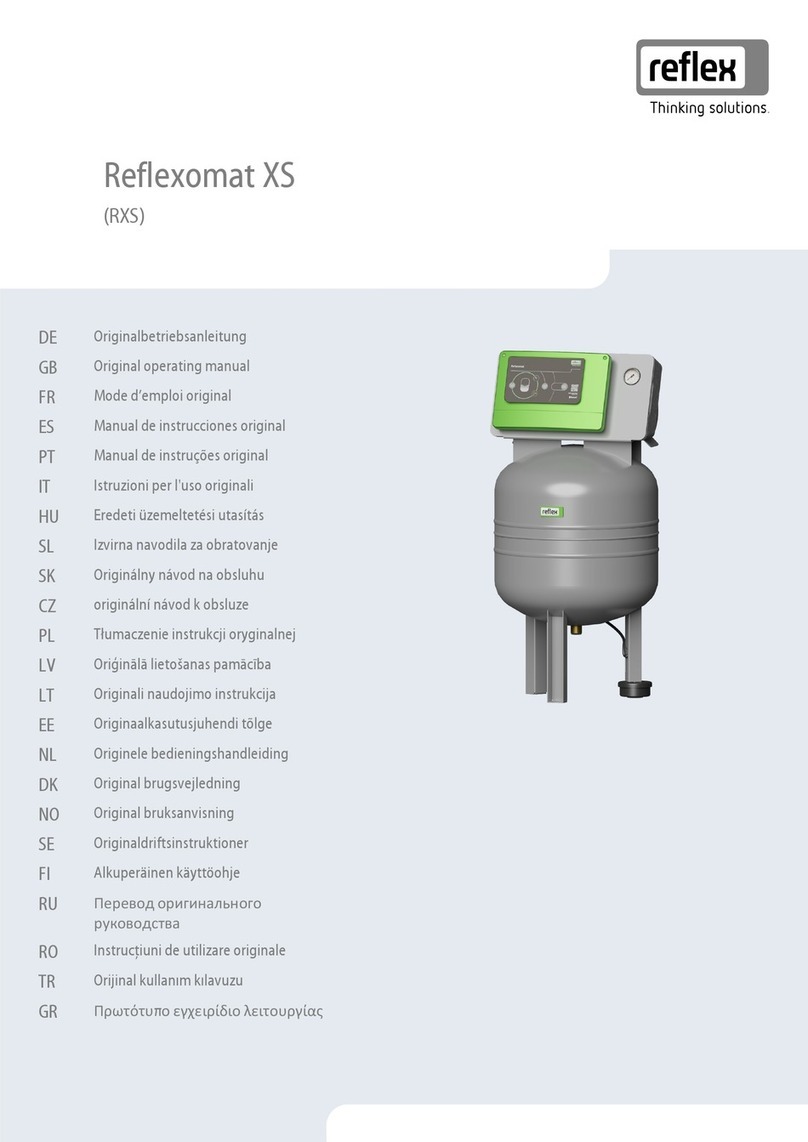
reflex ’variomat’ is a pump-controlled pressure-maintaining, degassing and water make-up station essentially
consisting of a ’variomat’ control unit with pressure sensor, pump, overflow valve, make-up solenoid valve and
safety valve and one or more ’variomat’ vessels.
A diaphragm divides the vessel into a water space and a gas space without a pressurised cushion of air.
The selected technical specification for fulfilment of the fundamental safety requirements outlined in Appendix I
of the directive 97/23/EC can be found on the name plate or in the declaration of conformity.
The declaration of conformity in the appendix certifies compliance with the EU directives 97/23/EC on pressure
equipment and 89/336/EC on electromagnetic compatibility.
Assembly, operation, inspection prior to start-up, periodic inspections
according to the national regulations (in Germany the Betriebssicherheitsverordnung (Ordinance on Industrial
Safety and Health)). In keeping with this, assembly and operation must be performed according to the state of
the art by qualified personnel and specially trained staff. The operator must arrange the necessary inspections
prior to start-up, after substantial modifications to the system and periodic inspections as per the requirements
of the Ordinance on Industrial Safety and Health. Recommended inspection intervals according to § 15 (5) of the
Ordinance on Industrial Safety and Health and classification of the ’variomat’ VG basic vessels and VF secondary
vessels in Table 2 of directive 97/23/EC, see the section “Inspection intervals”. Only VG basic vessels and VF
secondary vessels without visible external damage to the pressure vessel may be installed and operated. Tension-
free (moment-free) installation is required. An additional load from pipelines or devices is not permitted.
Proper assembly and start-up must be certified in the assembly, commissioning and maintenance
certificate (→p. 33). This is a requirement for warranty claims. We recommend having the initial start-up
as well as the annual maintenance performed by your Reflex Service (→p. 31).
Changes to the control unit or the ’variomat’ vessels
such as welding work or adjustments to the circuitry, for instance, are not permitted. If parts are exchanged, only
manufacturer’s original parts may be used.
Adherence to parameters
Details concerning the manufacturer, year of manufacture and serial number as well as the technical data are
provided on the name plate on the ’variomat’ VG basic vessels and ’variomat’ VF secondary vessels. Suitable
safety measures must be implemented to ensure adherence to the permissible maximum and minimum operating
parameters (pressure, temperature, electrotechnical data) specified on p. 29. Violation of the permissible
electrotechnical data and the permissible excess operating overpressure on the water side, both during operation
and when filling, must be ruled out.
Corrosion, incrustation
’variomat’ vessels are made from steel and feature an external coating. Inside, a diaphragm prevents the
expansion water coming into direct contact with the vessel walls. A corrosion allowance of 0.1 mm has been
taken into consideration for the wall thicknesses of the vessels with technical specification AD 2000 (→name
plate). The vessel connections are raw inside. The vessels may only be used in atmospherically closed systems
with non-corrosive and chemically non-aggressive and non-toxic waters. The ingress of atmospheric oxygen
into the entire heating and cooling water system due to permeation, make-up water and so on is to be reliably
minimised during operation. Water treatment systems are to be designed, installed and operated according to
the state of the art.
Thermal protection
In heating water systems, the operator must affix a warning notice near the ’variomat’ system if there is a risk of
injury from excessive surface temperatures.
Installation site
Adequate load-bearing capacity of the installation site must be ensured, taking into consideration the complete
filling of the ’variomat’ VG basic vessels and ’variomat’ VF secondary vessels with water. Installation in earthquake
zones is not permitted. The installation room must be frost-free. A drain is to be provided for the waste water.
Provision is to be made for the addition of cold water if necessary.
Electrical connection
Electrical wiring and connection must be performed by a qualified electrician according to the applicable local
regulations (electricity board, VDE and EN). The system must be de-energised before any work is carried out on
electrical components.
Failure to heed these instructions, in particular the safety instructions, may result in the destruction of and defects
in the ’variomat’, personal injury and impaired operation. Any and all claims for warranty and liability are excluded
if these instructions are violated.
General safety instructions
reflex ’variomat’
General
5





























